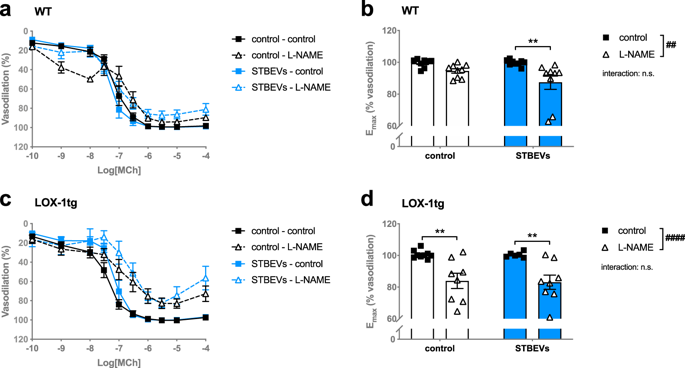Scientific Reports ( IF 3.8 ) Pub Date : 2020-04-08 , DOI: 10.1038/s41598-020-63205-2 Floor Spaans 1, 2 , Anita Quon 1, 2 , Raven Kirschenman 1, 2 , Jude S Morton 1, 2 , Tatsuya Sawamura 3, 4 , Dionne S Tannetta 5 , Ian L Sargent 6 , Sandra T Davidge 1, 2, 7

|
Vascular complications in pregnancy (e.g. preeclampsia) are a major source of maternal and foetal morbidity and mortality, and may be due to excessive release of placental syncytiotrophoblast-derived extracellular vesicles (STBEVs) into the maternal circulation. Increased activity of the multi-ligand scavenger receptor Lectin-like Oxidized LDL Receptor-1 (LOX-1) is associated with vascular dysfunction, and LOX-1 has been shown to interact with angiotensin II receptor type 1 (AT1). We hypothesized that STBEVs contribute to vascular dysfunction via LOX-1 and AT1 receptors during pregnancy. Uterine arteries from late pregnant wildtype and LOX-1 overexpressing mice were incubated overnight with or without STBEVs and vascular function was assessed using wire myography. STBEV-incubation decreased angiotensin II responsiveness only in wildtype mice, which coincided with decreased AT1 contribution and expression. Thus, STBEVs reduced angiotensin II responsiveness in normal pregnancy, but not in conditions of increased LOX-1 expression, suggesting that STBEVs (via LOX-1) play a role in normal adaptations to pregnancy. Oxidized LDL (a LOX-1 ligand) increased angiotensin II-induced vasoconstriction in STBEV-incubated arteries from both mouse strains, suggesting that the LOX-1 pathway may be involved in complicated pregnancies with elevated STBEVs and oxidized LDL levels (such as preeclampsia). These data increase our understanding of vascular complications during pregnancy.
中文翻译:

凝集素样氧化的LDL受体1和合体滋养层细胞外囊泡在妊娠期间小鼠子宫动脉血管反应中的作用。
妊娠中的血管并发症(例如先兆子痫)是孕产妇和胎儿发病率和死亡率的主要来源,并且可能是由于胎盘合体滋养层细胞衍生的细胞外囊泡(STBEVs)过度释放到孕产妇体内。多配体清除剂受体凝集素样氧化的LDL受体1(LOX-1)的活性增加与血管功能障碍有关,并且已证明LOX-1与1型血管紧张素II受体(AT1)相互作用。我们假设在怀孕期间STBEVs通过LOX-1和AT1受体导致血管功能障碍。将晚期妊娠野生型小鼠和过表达LOX-1的小鼠子宫动脉在有或没有STBEV的情况下孵育过夜,并使用线肌成像技术评估血管功能。STBEV孵育仅在野生型小鼠中降低了血管紧张素II的反应性,这与AT1的贡献和表达下降有关。因此,STBEVs在正常妊娠中降低了血管紧张素II的反应性,但在LOX-1表达增加的条件下并未降低,这表明STBEVs(通过LOX-1)在正常适应妊娠中起作用。氧化的LDL(一种LOX-1配体)增加了这两种小鼠品系在STBEV孵育的动脉中血管紧张素II诱导的血管收缩,表明LOX-1途径可能与STBEVs升高和氧化的LDL水平(如先兆子痫)有关的复杂妊娠。 。这些数据增加了我们对妊娠期间血管并发症的了解。提示STBEV(通过LOX-1)在正常适应妊娠中起作用。氧化的LDL(一种LOX-1配体)增加了这两种小鼠品系在STBEV孵育的动脉中血管紧张素II诱导的血管收缩,表明LOX-1途径可能与STBEVs升高和氧化的LDL水平(如先兆子痫)有关的复杂妊娠。 。这些数据增加了我们对妊娠期间血管并发症的了解。提示STBEV(通过LOX-1)在正常适应妊娠中起作用。氧化的LDL(一种LOX-1配体)增加了这两种小鼠品系在STBEV孵育的动脉中血管紧张素II诱导的血管收缩,表明LOX-1途径可能与STBEVs升高和氧化的LDL水平(如先兆子痫)有关的复杂妊娠。 。这些数据增加了我们对妊娠期间血管并发症的了解。











































 京公网安备 11010802027423号
京公网安备 11010802027423号